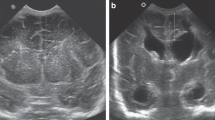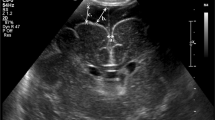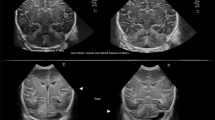Abstract
Objective:
To document the incidence, natural history and compare neurodevelopmental outcome of newborns with and without frontal horn cysts (FHC).
Study Design:
This was a case–control study. Newborns with and without FHC were identified and matched for demographics and worst cranial ultrasound scan (CUS) findings. Neurodevelopmental outcome was assessed at 18 to 24 months.
Result:
A total of 30 FHC cases were identified from medical imaging database. Twenty-five cases occurred in preterm ⩽32 weeks gestation with an incidence of 1% (25 of 2340). The diagnosis was made on the initial CUS in 28 cases. The cyst size and number varied from 1 to 18 mm and 1 to 6 respectively with no change noted on repeat CUS during hospital stay. Neurodevelopmental outcomes were not statistically significantly different between the groups.
Conclusion:
FHC are not uncommon in the newborn period. They appear to be benign with no impact on neurodevelopmental outcome. This information is vital for counseling parents of infants with FHC.
This is a preview of subscription content, access via your institution
Access options
Subscribe to this journal
Receive 12 print issues and online access
$259.00 per year
only $21.58 per issue
Buy this article
- Purchase on Springer Link
- Instant access to full article PDF
Prices may be subject to local taxes which are calculated during checkout

Similar content being viewed by others
References
Ment LR, Bada HS, Barnes P, Grant PE, Hirtz D, Papile LA et al. Practice parameter: neuroimaging of the neonate: report of the Quality Standards Subcommittee of the American Academy of Neurology and Practice Committee of the Child Neurology Society. Neurology 2002; 58: 1726–1738.
Chang CL, Chiu NC, Ho CS, Li ST . Frontal horn cysts in normal neonates. Brain Dev 2006; 28: 426–430.
Keller MS, DiPietro MA, Teele RL, White SJ, Chawla HS, Curtis-Cohen M et al. Periventricular cavitations in the first week of life. Am J Neuroradiol 1987; 8: 291–295.
Lu JH, Emons D, Kowalewski S . Connatal periventricular pseudocysts in the neonate. Pediatr Radiol 1992; 22: 55–58.
Pal BR, Preston PR, Morgan ME, Rushton DI, Durbin GM . Frontal horn thin walled cysts in preterm neonates are benign. Arch Dis Child 2001; 85: F187–F193.
Rademaker KJ, De Vries LS, Barth PG . Subependymal pseudocysts: ultrasound diagnosis and findings at follow-up. Acta Paediatr 1993; 82: 394–399.
Ramenghi LA, Domizio S, Quartulli L, Sabatino G . Prenatal pseudocysts of the germinal matrix in preterm infants. J Clin Ultrasound 1997; 25: 169–173.
Rosenfeld DL, Schonfeld SM, Underberg-Davis S . Coarctation of the lateral ventricles: an alternative explanation for subependymal pseudocysts. Pediatr Radiol 1997; 27: 895–897.
Sudakoff GS, Mitchell DG, Stanley C, Graziani LJ . Frontal periventricular cysts on the first day of life. A one-year clinical follow up and its significance. J Ultrasound Med 1991; 10: 25–30.
Thun-Hohenstein L, Forster I, Künzle C, Martin E, Boltshauser E . Transient bifrontal solitary periventricular cysts in term neonates. Neuroradiology 1994; 36: 241–244.
Wong F, Fraser S, Kelly E, Acton C . Clinical significance of isolated paraventricular cysts on cranial ultrasonography. J Paediatr Child Health 2004; 40: 552–555.
Zorzi C, Angonese I . Subependymal pseudocysts in the neonate. Eur J Pediatr 1989; 148: 462–464.
Epelman M, Daneman A, Blaser SI, Ortiz-Neira C, Konen O, Jarrín J et al. Differential diagnosis of intracranial cystic lesions at head US: correlation with CT and MR imaging. Radiographics 2006; 26: 173–196.
Section on Ophthalmology, American Academy of Pediatrics, American Academy of Ophthalmology and American Association for Pediatric Ophthalmology and Strabismus. Screening examination of premature infants for retinopathy of prematurity. Pediatrics 2006; 117: 572–576.
Skellern CY, Rogers Y, O'Callaghan MJ . A parent-completed developmental questionnaire: follow up of ex-premature infants. J Paediatr Child Health 2001; 37: 125–129.
Bzoch K, League R . Receptive-Expressive Emergent Language Test: A Method for Assessing the Language Skills of Infants. Second edn. Pro-Ed: Austin, 1991.
Epelman M, Daneman A, Blaser SI, Ortiz-Neira C, Konen O, Jarrín J et al. Differential diagnosis of intracranial cystic lesions at head US: correlation with CT and MRI imaging. Radiographics 2006; 26: 173–196.
Author information
Authors and Affiliations
Corresponding author
Ethics declarations
Competing interests
The authors declare no conflict of interest.
Additional information
Abstract presented at The Society for Pediatric Research Meeting, Honolulu, Hawaii, USA, 3–6 May 2008 and Canadian Paediatric Society Meeting, Victoria, British Columbia, Canada, 24–28 June 2008.
Rights and permissions
About this article
Cite this article
Unger, S., Salem, S., Wylie, L. et al. Newborn frontal horn cysts: cause for concern?. J Perinatol 31, 98–103 (2011). https://doi.org/10.1038/jp.2010.79
Received:
Revised:
Accepted:
Published:
Issue Date:
DOI: https://doi.org/10.1038/jp.2010.79
Keywords
This article is cited by
-
Benign frontal horn cysts in a preterm neonate
Journal of Perinatology (2014)



